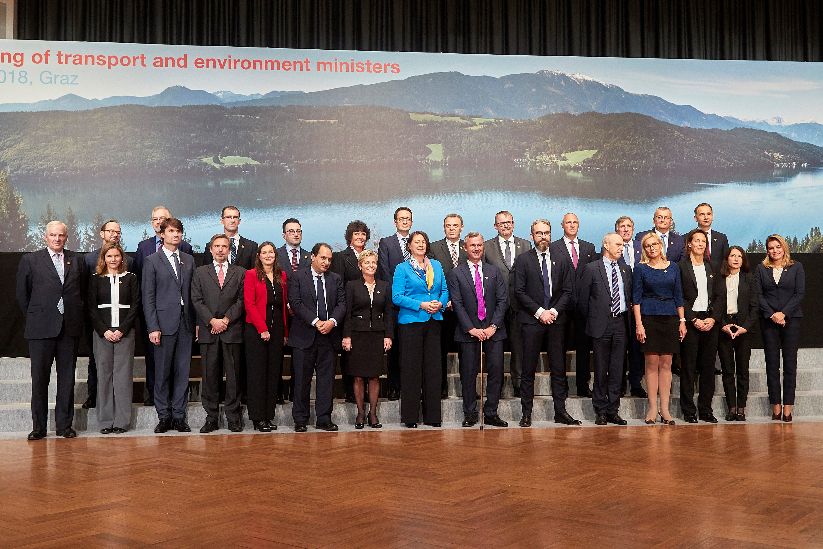
Human factors, vehicles and infrastructure at the heart of the EU programme “Road safety 2020+”
Informal meeting of transport ministers in Graz sets the wheels in motion for a new set of measures
To conclude the 2‑day informal meeting of EU ministers in Graz, the EU transport ministers, under the chairmanship of Austrian Federal Minister Norbert Hofer, held deliberations on 30 October on measures to increase road safety in the European Union. The measures under the Road safety 2020+ initiative focus particularly on the triangle that is comprised of human factors, vehicles and infrastructure.
“European road safety efforts have experienced great success in recent years. While the number of road traffic accidents has stagnated in some EU member states, it has even increased in some other countries. Austria thus welcomes the European Union’s intensive efforts to continually improve road safety. An increase in mobility within our modern society and successful work in the area of road safety are not a contradiction in terms”,
explained transport minister Norbert Hofer.
More than half of EU member states have already started work on national road safety programmes. In the case of 70% of states, these measures will be put in place over the coming 10 years. The leading causes of road accidents are inappropriate speed, driver distraction as well as alcohol and drug misuse. Transport minister Norbert Hofer took the opportunity to present to his EU counterparts the current Austrian road safety campaign “Lass Drogen nicht ans Steuer” (“Don’t drug and drive”), which is designed to raise awareness of the dangers of driving under the influence of drugs. The EU’s road safety programme 2020+ also takes into account developments in automated driving, the exact implications of which cannot yet be predicted, however. During the sessions, three keynote speakers (ministers Andreas Scheuer from Germany, Laszlo Palkovics from Hungary and Tomas Eneroth from Sweden) presented their ideas for road safety measures in the following areas: human factors, vehicles and infrastructure.
Violeta Bulc, the EU Commissioner for Transport, made a fervent appeal to member states to undertake efforts on the road safety strategy:
“Road traffic safety is an extremely important topic. Accident statistics do not merely represent numbers, but people and families. Accidents cause heartbreaking grief. For this reason, the topic is very high up on the political agenda. In the new road safety programme, we want to take a look at all the factors involved in accidents: vehicles, infrastructure, driver behaviour and the emergency rescue chain.”
The third Mobility Package of the EU Commission contains numerous measures intended to mitigate the consequences of accidents. Commissioner Bulc advised the EU transport ministers to also extend the measures to include national roads, especially as, on average, 39% of all fatal accidents in Europe happen on these roads – in comparison, “only” 9% of deadly accidents occur on motorways. The third Mobility Package also includes 16 new vehicle safety features, which the EU Commission considers to be cost‑efficient and entirely feasible and will substantially improve the protection of vehicle occupants.
“By 2050, we would like to be as close as possible to “Vision Zero” (note: 0 fatalities on the road). We have the ambitious target of reducing by 50% the number of fatalities and serious injuries from road accidents by 2030”,
said EU Commissioner for Transport Violeta Bulc.
The EU transport ministers welcomed the decision of the Austrian Presidency of the Council of the EU to dedicate a separate session to road safety. In their statements, the ministers reaffirmed that improving road safety was just as important to them as it was to the Commission. Many members states believe that, in addition to “classic” measures, automated driving also offers opportunities to improve accident statistics. Nearly all countries believe that driver distraction is one of the biggest problems and that further efforts in the form of awareness‑raising campaigns are needed.
“This informal meeting is a further milestone on the way to reaching our common goal of reducing the number of people who are seriously injured or killed in road accidents.” Under the Safe System approach the responsibility for accidents will no longer lie with road users alone. All those who plan and provide infrastructure also influence transport demand, the flow of traffic and traffic conflicts. At the end of the day, they can therefore help to avoid accidents. Measures are therefore needed to achieve the best possible synergy effects. The ideal way to achieve these is through the targeted planning and implementation of road safety programmes at an international and national level”,
was the positive conclusion of Austrian transport minister Norbert Hofer, who currently chairs the Council meetings in the area of transport. At the same time, he urged his colleagues to continue planning their national road safety programmes for the 2021‑2030 period in a proactive and speedy manner.
“We are doing this to provide a safe Europe for all citizens.”
More information about this event can be found on the event page.
Volker Höferl
Spokesperson for the Federal Transport Minister
+43 1 71 162-65 81 21
volker.hoeferl@bmvit.gv.at